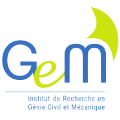
- Cet évènement est passé
Séminaire – Carlos OVALLE – Geotechnical Engineering for Mine Waste Storage Facilities in Chile
26 février 2016 à 14 h 00
Carlos OVALLE (Department of Structural and Geotechnical Engineering, Pontificia Universidad Católica de Chile) actuellement professeur invité en géotechnique au GeM au sein de l’équipe MEO, donnera un séminaire à l’Ecole Centrale de Nantes le 26 février 2016 à 14h00.
Résumé de la présentation:
Geotechnical Engineering for Mine Waste Storage Facilities in Chile
Over the last two decades, the world-wide demand for copper has been rising steadily. Hence, some of the large copper recovery operations (>100,000 tonnes per day) in Chile, mainly located in the high Andes Mountains of the Atacama Desert, are looking to expand their production. Although rich in minerals, the Atacama Desert presents difficult natural conditions for mining operations, namely, it is extremely dry and it is a high seismic hazard region.
Typically, after the mineral recovering process 99% of the rock extracted from the mine is waste in the form of two main types: (a) sterile waste rock and (b) slurry tailings. Waste rock is composed by very coarse rock blocks and finer fractions deposited in large rock dumps reaching hundreds of meter high, where the material could be exposed to mechanical degradation due to very high stresses. On the other hand, slurry tailings are typically a mix of sand and non-plastic silt. The most common tailings management method is the hydraulic discharge of the slurry into a storage facility confined by dams, containing loose and saturated tailings. Under these conditions, earthquakes could trigger tailings liquefaction and there is a well-documented history of earthquake-induced tailings dam failures (Dobry & Alvarez, 1967; Castro & Troncoso, 1989; Troncoso & Avendaño, 1993; Villavicencio el al., 2013).
Geotechnical engineering has a key role to play in safe engineering designs of mine waste deposits. However, common design methods are in general quite simplified and not always adapted for innovative waste deposition systems. Consequently, there is a need for more sophisticated methodologies. In this seminar, a brief description of massive copper mine waste production is presented. Examples of experimental mechanical characterization and numerical simulations of waste deposits are shown in order to analyze the seismic stability of new deposition methods recently applied in Chile.


